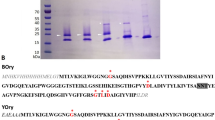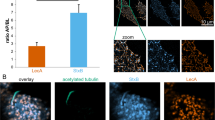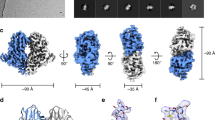Abstract
PLANT lectins have proved to be useful probes of the surface properties of a variety of cells and membranes, providing data on the relative mobility of intramembranous macro-molecules in different conditions1 and on the organisation of oligosaccharides on the cell surface. We report here the use of fluorescent concanavalin A (con A) as a probe to analyse the surface properties of the unfertilised and fertilised mouse egg. Similar experiments were carried out independently at both Cambridge and Birmingham and the results are combined.
This is a preview of subscription content, access via your institution
Access options
Subscribe to this journal
Receive 51 print issues and online access
$199.00 per year
only $3.90 per issue
Buy this article
- Purchase on Springer Link
- Instant access to full article PDF
Prices may be subject to local taxes which are calculated during checkout
Similar content being viewed by others
References
Nicolson, G. L., Int. Rev. Cytol., 39, 89–190 (1974).
Odor, D. L., and Renninger, D. F., Anat. Rec., 137, 13–23 (1960).
Szollosi, D., J. Cell Biol., 44, 192–209 (1970).
Weiss, L., and Subjeck, R., J. Cell Sci., 14, 215–223 (1974).
Whittingham, D. G., J. Reprod. Fert., suppl., 14, 7–21 (1971).
Author information
Authors and Affiliations
Rights and permissions
About this article
Cite this article
JOHNSON, M., EAGER, D., MUGGLETON-HARRIS, A. et al. Mosaicism in organisation of concanavalin A receptors on surface membrane of mouse egg. Nature 257, 321–322 (1975). https://doi.org/10.1038/257321a0
Received:
Accepted:
Published:
Issue Date:
DOI: https://doi.org/10.1038/257321a0
This article is cited by
-
Phosphatidylserine on viable sperm and phagocytic machinery in oocytes regulate mammalian fertilization
Nature Communications (2019)
-
Effects of dimethyl sulfoxide on asymmetric division and cytokinesis in mouse oocytes
BMC Developmental Biology (2014)
-
Polyspermy prevention: facts and artifacts?
Journal of Assisted Reproduction and Genetics (2011)
-
First cleavage plane of the mouse egg is not predetermined but defined by the topology of the two apposing pronuclei
Nature (2004)
-
Mechanisms of regulation of early embryogenesis
Russian Journal of Developmental Biology (2000)
Comments
By submitting a comment you agree to abide by our Terms and Community Guidelines. If you find something abusive or that does not comply with our terms or guidelines please flag it as inappropriate.



